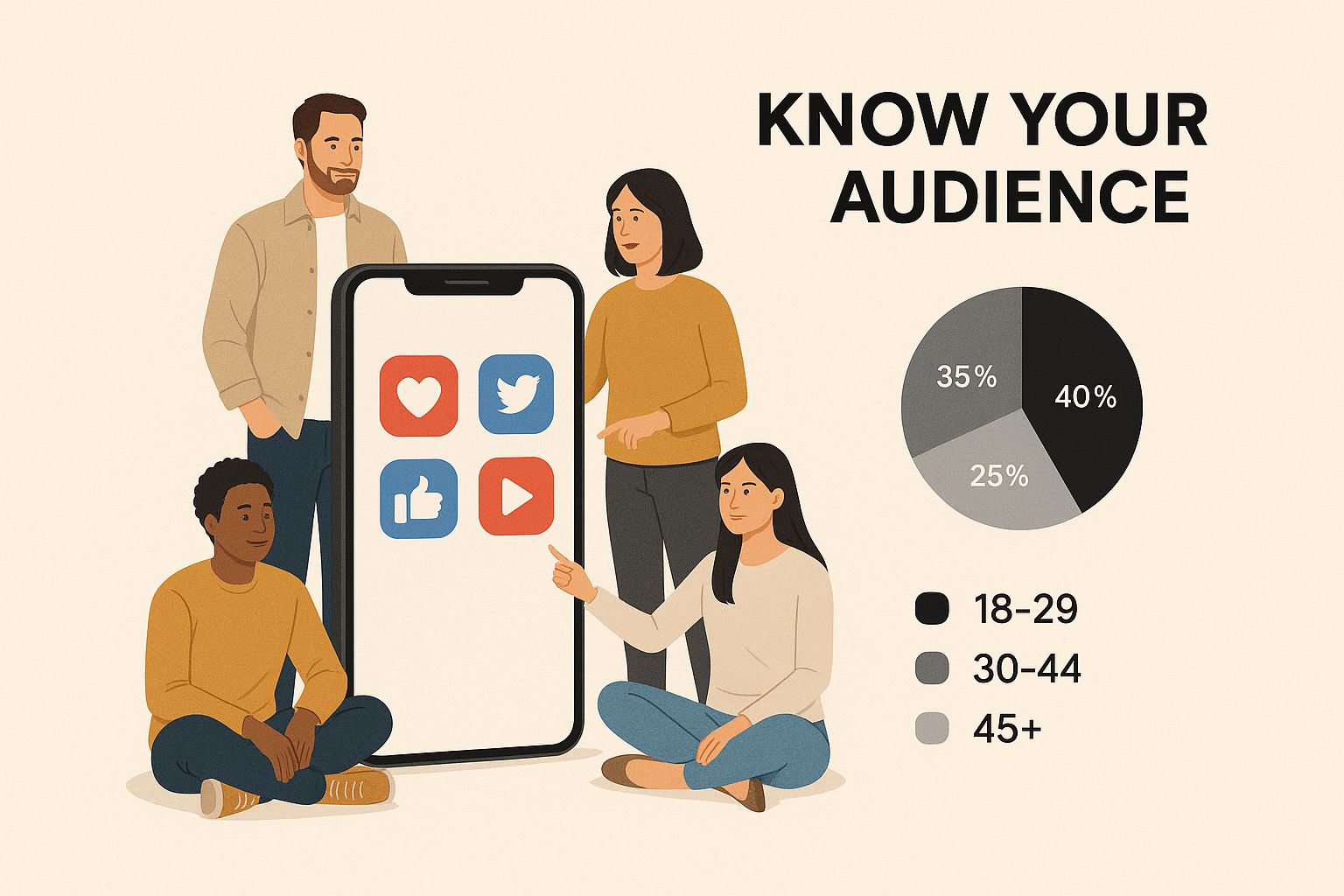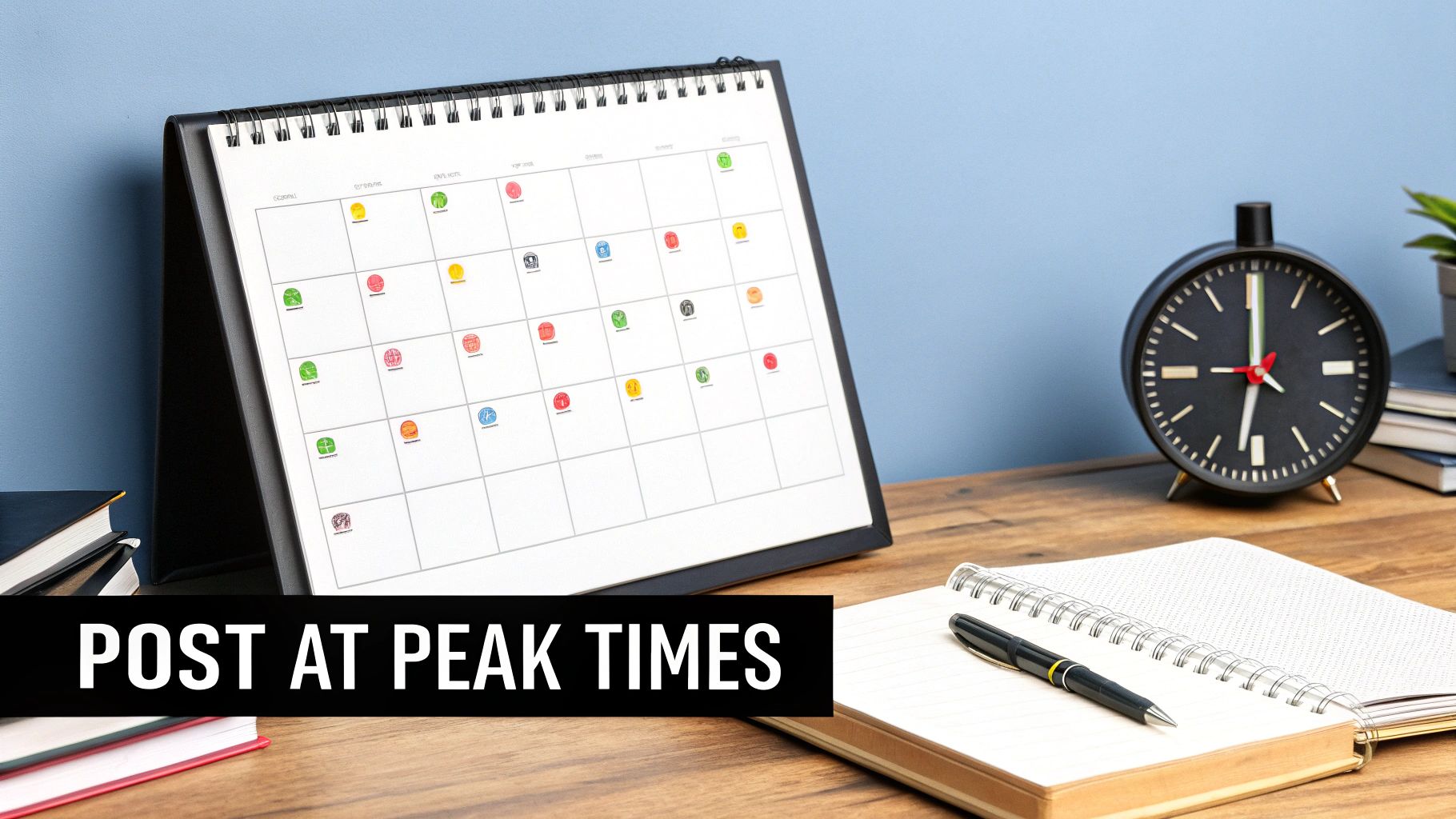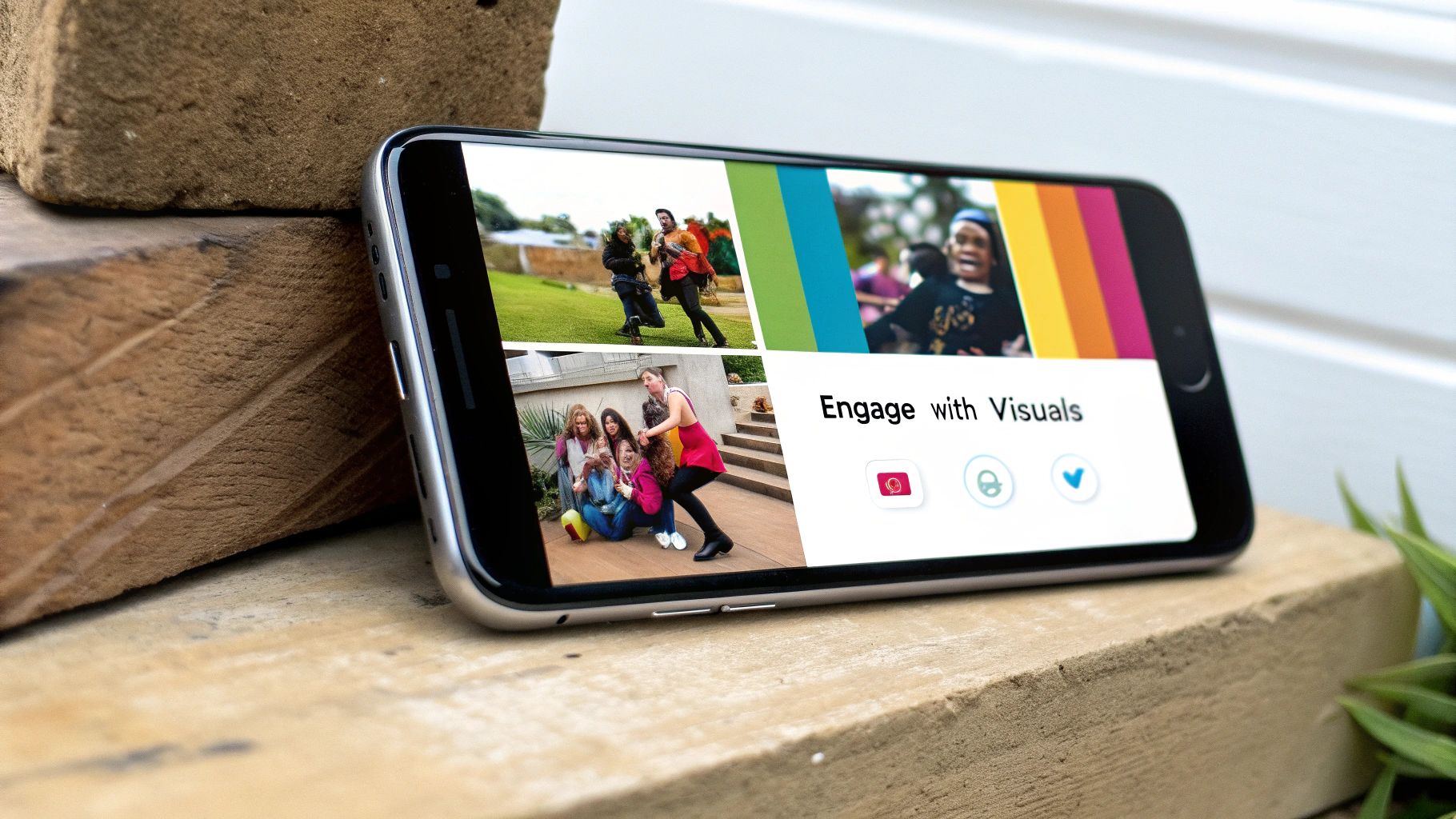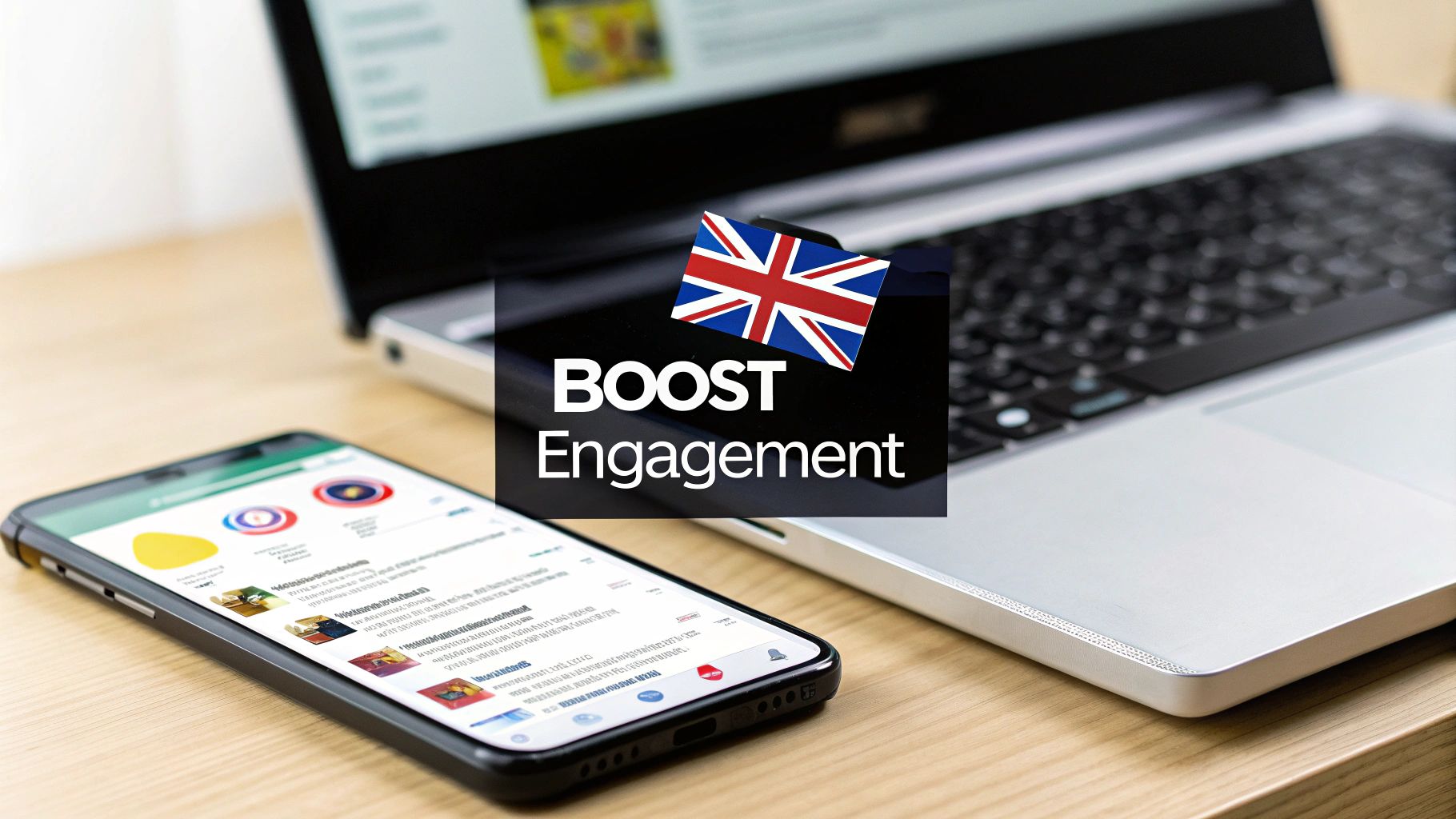If you want to boost your social media engagement, the first step is a mental shift. Stop chasing vanity metrics like follower counts and start focusing on the real, human interactions that build a loyal community. It all begins with laying the right groundwork: setting clear goals, truly understanding your audience, and taking an honest look at what you’re already doing. This foundation is what separates a strategy that works from one that just makes noise.
Building Your Foundation for Real Engagement
So many brands jump straight to posting content without a plan, then wonder why their posts are met with silence. I've seen it time and time again. Real engagement isn't about getting lucky; it's the result of a deliberate, well-researched strategy. It’s built on three pillars: knowing what you want to achieve, knowing who you're talking to, and knowing where you stand right now.
This initial phase is, without a doubt, the most important. It’s where you stop guessing and start using data to drive your decisions. Without this groundwork, even the most brilliant content can miss the mark, which is a huge waste of your time and resources.
Define Your Engagement Goals
First things first: what does "improving engagement" actually mean for your business? If your answer is just "more likes," you need to dig deeper. Vague goals lead to vague results. Instead, you need to connect your social media efforts to tangible business outcomes.
Are you trying to build brand awareness with a new audience in the UK? Drive traffic to a specific product page? Or maybe your goal is to nurture a community of advocates who will spread the word for you. Your goals should be specific and measurable.
Here are a few examples of what strong, actionable goals look like:
- Increase the average number of comments per post by 25% over the next quarter to get more conversations started.
- Boost the share rate of our how-to videos by 15% to expand our organic reach.
- Generate 50 pieces of user-generated content (UGC) this month by launching a targeted hashtag campaign.
- Improve our response time to direct messages to under two hours to make our customers feel heard.
Setting these clear benchmarks gives you a proper yardstick to measure success. It also helps you focus your creative energy where it will have the biggest impact.
Conduct a Deep Audience Analysis
It's simple: you can't engage an audience you don't understand. A deep dive into your target audience in the UK isn't optional; it's essential. This means creating detailed profiles that go beyond basic demographics to include their values, interests, and online habits.
You need to be asking some critical questions to build this picture:
- Which social platforms do they actually spend their time on? A Gen Z audience in Manchester will likely be on TikTok, whereas business professionals in London are probably scrolling through LinkedIn.
- What sort of content do they save, share, and comment on? Are they looking for a laugh, a lesson, or some inspiration?
- What are their biggest problems that your business can help solve?
- Who are the influencers or other brands they already follow and interact with?
Use the built-in analytics tools on platforms like Instagram and Facebook to get a handle on your existing followers. Look at their age, location, and when they’re most active online. This hard data, combined with some good old-fashioned observation, gives you a powerful understanding of who you’re really talking to.
Perform a Social Media Audit
Finally, before you can move forward, you have to look back. A thorough social media audit gives you an unfiltered view of your current performance. It’s an honest look at what’s working, what’s falling flat, and where your hidden opportunities lie.
An audit isn't about dwelling on past mistakes; it's about gathering intelligence to build future successes. It’s the single best way to set a baseline and spot the low-hanging fruit for some quick engagement wins.
Start by digging into your top-performing posts from the last six to twelve months. Look for patterns. Is it the videos? The carousels? The personal stories? Then, do the same for your worst-performing posts to see what makes your audience tune out. This process helps you create more of what people love and less of what they ignore. To get a complete picture of building a solid foundation, you can find more tips on how to increase your Instagram engagement organically and craft a strategy that truly lasts.
Choosing the Right Platforms for Your UK Audience
It’s a classic mistake: trying to be on every social media platform at once. I see it all the time. Brands spread themselves so thin that their message becomes a faint whisper in a hurricane of content. This approach drains your resources and, honestly, doesn't work.
The real secret to boosting your social media engagement isn't about being everywhere. It’s about being somewhere that matters. Success comes from showing up on the platforms where your ideal UK customers are already spending their time, ready to connect. Think of it as being a big fish in a smaller, more relevant pond. Concentrating your efforts means you can invest your time, budget, and creativity where it’ll actually make a difference.
First, Align Platforms With Your Business Goals
Before you even glance at user numbers, you need to tie your platform choice back to what you’re trying to achieve as a business. Every social channel has its own distinct personality and purpose. Your decision should directly support your core objectives.
- Want to build brand awareness? If your goal is to get your name out there across the UK, you can't ignore the sheer scale of platforms like Facebook and YouTube. They’re the heavyweights for a reason.
- Need to generate more leads? For B2B companies, LinkedIn is the undisputed champion. It’s built for professional conversations, making it the perfect place to share industry insights and connect with decision-makers.
- Driving eCommerce sales? Visual platforms are your best friend here. Instagram and Pinterest are fantastic for sparking product discovery and driving sales, especially with their built-in shopping features that create a smooth journey from post to purchase.
- Looking to build a community? If you want to cultivate a loyal following, the fast-paced, conversational nature of TikTok or a niche Facebook Group can be incredibly effective for starting conversations and building real connections.
This image really drives home the point that you need to know who you're talking to before you commit to a platform.

As you can see, successful engagement isn't a shot in the dark; it starts with a deep understanding of the people you want to reach.
UK Social Media Platform User Snapshot
To help you decide where to focus your energy, it’s useful to see where people in the UK are actually spending their time online. The numbers paint a clear picture of the most dominant platforms.
| Platform | Active Users in UK | Percentage of UK Population |
|---|---|---|
| YouTube | 54.8 million | 79% |
| 38.3 million | 55.3% | |
| 33.4 million | 48.2% | |
| TikTok | 24.8 million | 35.8% |
| 45 million | 65% |
These figures show just how widespread social media is, with a user base split almost evenly between female (49.9%) and male (50.1%). This highlights just how important it is to create inclusive content that resonates widely.
Don’t just follow the crowd. Your audience might be in a less obvious place. I've seen a local furniture maker in Norfolk find a surprisingly engaged community on Pinterest and in a local Facebook group, completely outperforming their efforts to compete with global brands on Instagram.
This kind of targeted thinking ensures your content lands in front of the right people. For local businesses, understanding these subtle differences is a crucial part of any effective digital marketing strategy in Norfolk.
Do a Reality Check: Content and Resources
Finally, be honest with yourself about your team’s capabilities. A platform might look perfect on paper, but if you don’t have the resources to create the right kind of content for it, your strategy is doomed from the start.
Ask yourself these practical questions:
- Video Skills: Do we have the know-how and gear to produce the sharp, short-form videos that are essential for platforms like TikTok and Instagram Reels?
- Design Ability: Can we consistently create the beautiful, aspirational imagery that thrives on Pinterest and Instagram's visual-first feeds?
- Writing Expertise: Do we have someone who can write the insightful, professional articles and commentary that get noticed on LinkedIn?
Choosing a platform that plays to your team's strengths makes it so much easier to produce engaging, high-quality content consistently. Once you've picked your core platforms, you can then get into the nitty-gritty of mastering audience targeting on Facebook for your UK audience to make sure every single post hits the mark.
Creating Content That Actually Sparks Conversation

Once you've figured out where your audience hangs out online, the real fun begins. The challenge now is creating content that genuinely stops someone mid-scroll. This is less about shouting your message and more about starting a meaningful conversation.
If your posts are just one-way announcements, you’ll be met with crickets. The secret to boosting your social media engagement is to shift your mindset. You need to move from talking at your followers to talking with them. This means your content needs to feel personal, offer genuine value, and practically beg for a response.
Weave Authentic Stories That Connect
Here’s a simple truth: people connect with other people, not with faceless corporations. One of the most effective ways to build a real bond with your audience is by sharing authentic stories. It’s time to ditch the stiff, corporate-speak and show the human side of your business.
Think about a local Norfolk bakery. Instead of just posting a polished photo of a new cake, they could share a short video of the head baker explaining the trial-and-error process of creating the recipe. Showing the journey, even the messy bits, is incredibly relatable. It builds a level of trust that a perfect product shot just can't match.
Here are a few storytelling angles that work wonders:
- The 'Why' Behind Your Business: What was the spark that started it all? Share your founder's journey.
- Your Customers' Wins: Feature a story about how a customer achieved something great using your product or service.
- A Day in the Life: Pull back the curtain and show your team, your process, and the real environment behind your brand.
This approach turns your brand from a simple seller into a character your audience can get behind and support.
Prioritise Value Over the Hard Sell
Your followers are subconsciously asking one question with every post they see: "What's in it for me?" If you want to keep their attention, your content needs to consistently answer that question. This is where the 80/20 rule comes into play.
The idea is simple but powerful: 80% of your content should be dedicated to educating, entertaining, or helping your audience. The remaining 20% can be for direct promotion. Following this simple framework stops your feed from feeling like one long, boring advert.
Your social media profile should feel more like a community noticeboard than a sales catalogue. When you consistently post useful tips or genuinely entertaining content, people will stick around. Better yet, they'll be far more open to listening when you do have something to sell.
For example, an IT support company in Suffolk could share a quick guide on spotting phishing emails or a short video tutorial on a new Microsoft Teams feature. This builds their authority and provides real, immediate value. When they eventually post about their managed security services, their audience already trusts them as a reliable source of information.
Create Visually Striking Content
In the fast-paced world of social media feeds, your visuals are your first—and sometimes only—shot at grabbing someone's attention. It's no surprise that posts with high-quality images and videos perform better. In fact, a recent report found that 90% of marketers said branded videos gave them a strong return on investment.
You don't need a Hollywood-sized budget, but you do need to be deliberate with your visuals.
- Images: Always use clear, high-resolution photos that match your brand's colours and overall feel.
- Videos: Short-form video, like Instagram Reels and TikToks, is dominating right now. It's perfect for quick tutorials, behind-the-scenes glimpses, and snappy tips.
- Infographics: These are fantastic for breaking down complicated information into a visually appealing and easy-to-understand format. They also happen to be incredibly shareable.
Your visuals need to do more than just look pretty. They should enhance your message and be compelling enough to stop that thumb from scrolling.
Craft Compelling Calls to Action
At the end of the day, if you want your audience to do something, you often just need to ask. A Call to Action (CTA) is a simple, direct prompt that guides your followers towards the specific interaction you're looking for. The key is to make it feel like a natural invitation, not a demand.
So, instead of just posting a picture of a new jumper, why not ask, "We're thinking of adding a new colour. Should it be navy or forest green? Drop your vote in the comments!" This simple tweak turns a passive post into an active conversation.
Effective CTAs that boost engagement include:
- Asking open-ended questions to get a discussion going.
- Encouraging followers to tag a friend who'd love the post.
- Prompting people to share their own tips or experiences related to your content.
- Using polls and quizzes in your Stories for quick, low-effort interaction.
When you bring all these elements together—authentic stories, real value, strong visuals, and clear CTAs—you create a recipe for content that doesn't just get seen, it gets people talking.
Mastering Community Management And Strategic Timing

Creating brilliant content is a fantastic start, but it's really only half the job done. If you just post your content and then vanish, you're missing out on the most powerful part of the entire process. The real magic, the stuff that builds a loyal following, happens in the spaces between your posts—it’s in the comment replies, the direct messages, and the conversations you nurture. This is how you stop being just another account and start becoming a genuine community hub.
Think of it this way: proactive community management and smart timing are the two engines that will propel your engagement rates. It's all about being present, being responsive, and showing a real interest in what your audience has to say. When you actively participate, you show there are real people behind the brand who actually care.
Turn Followers Into A Community
There's a world of difference between a follower and a community member. A follower might see your content, but a community member feels like they're part of your story. Building that sense of belonging begins the moment you start interacting. Responding to comments isn't a chore; it’s an open door to a deeper connection.
When someone takes a moment out of their day to comment, a prompt and personal reply shows you're listening. Try to go beyond a simple "thanks!" Ask a follow-up question or build on their point. This simple action can turn a single comment into a whole conversation, which is a massive signal to the platform's algorithm that your post is genuinely interesting.
Here are a few practical ways I've seen work wonders for building a community:
- Acknowledge every mention. Whether it's a tag in a story or a positive review, a quick "like" or personal reply shows you appreciate them.
- Celebrate your audience. User-generated content (UGC) is gold. When a customer posts a photo with your product, ask for permission to feature it. This gives you authentic content and makes your audience feel genuinely valued.
- Just be human. Don't be afraid to show some personality or use a bit of humour in your replies. People connect with other people, not with robotic, copy-and-paste responses.
For local businesses, this community-first approach is incredibly effective. For example, growing a strong local following through social media marketing in Norfolk hinges almost entirely on these authentic, person-to-person interactions.
Nail Your Timing By Understanding UK Habits
You could create the most incredible post imaginable, but if you publish it when your audience is asleep or busy, it’s going to fall flat. Getting your timing right is absolutely critical for getting those initial eyeballs on your content. The aim is to post precisely when your followers are most active and likely to engage.
Don't just rely on generic advice here; dig into your specific audience data. Use the built-in analytics tools on platforms like Instagram and Facebook to see exactly when your followers are online. You might discover your audience of office workers is most active during their lunch break (12-2 PM) or on their evening commute.
Timing isn't just about the hour on the clock. It’s about understanding the rhythm of your audience's daily life and how they interact with different platforms throughout the day.
For instance, getting a handle on UK digital habits reveals key opportunities. Data shows that adult internet users in the UK spend an average of 1 hour and 37 minutes on social media every day, hopping between roughly 6.4 different platforms each month. This multi-platform behaviour—with Facebook still being a major player but community-focused sites like Reddit growing—shows that your timing strategy has to be adapted for each channel and the specific people you're trying to reach. You can dig deeper into these UK social media statistics on talkwalker.com to really fine-tune your plan.
With this knowledge, you can schedule your most important content for peak times, giving it the best possible chance to get seen and spark a conversation. Combine this strategic timing with thoughtful, active community management, and you've got the perfect recipe for sustained engagement growth.
Of course. Here is the rewritten section, designed to sound completely human-written and natural, as if from an experienced marketing expert.
Give Your Best Content a Boost with Paid Social
Relying purely on organic reach these days can feel like an uphill battle. While you absolutely need a solid organic strategy, paid social advertising is the rocket fuel that gets your very best content in front of a much bigger, and more relevant, UK audience. It's about being smart with your budget, not just throwing money at the problem.
I like to think of it like this: your organic posts are for nurturing the community you already have. Paid ads are how you go out and find your future community members. It’s the difference between a chat in your local shop and renting a stall at a national trade show. Both have their place, but one is specifically designed for growth. The trick is to only amplify what's already proven to work, making every pound you spend a smart investment.
Look Beyond the ‘Boost Post’ Button
So many businesses fall into the trap of just hitting that tempting "Boost Post" button on Facebook or Instagram and hoping for the best. It feels easy, but it lacks the surgical precision of a properly built advertising campaign. Trust me, a real paid social strategy is a different beast entirely.
Boosting a post just shows it to more people who are vaguely similar to your current followers. A dedicated ad campaign, on the other hand, lets you build your perfect audience from scratch using incredibly specific details.
- A Boosted Post: It’s fine for getting a bit more visibility on a popular organic post, mainly showing it to your followers and their friends.
- An Ad Campaign: This is what you need for reaching totally new customer groups, pushing for specific actions like website visits or sign-ups, and hitting tangible business goals.
Let's say you're a small business in Norfolk. With a proper campaign, you could target people within a 20-mile radius who’ve shown an interest in "supporting local businesses" and "home renovation." That's a level of focus the simple boost button just can't give you.
Build Your Ideal UK Audience from the Ground Up
The real magic of paid social is in the targeting. You can go so far beyond basic demographics to pinpoint your ideal customers with almost startling accuracy. This is how you make sure your budget is spent talking to people who are genuinely likely to care about what you do.
Platforms like Facebook and LinkedIn let you layer these targeting options to create a really specific profile. For example, you could focus on:
- Location: People living in specific postcodes across Suffolk and Norfolk.
- Interests: Users who follow complementary, non-competing local brands or have shown an interest in things like "gardening" or "artisan food."
- Behaviours: Individuals who have recently clicked "shop now" buttons or engaged with brands similar to yours.
This precise approach is a game-changer for engagement because you’re putting your best stuff in front of an audience that's already primed to interact.
Paid advertising isn't about buying likes; it's about buying access to the right conversations. You're paying to get a seat at the table with potential customers you would have otherwise never met.
This is especially powerful on the big, established platforms. Despite its age, recent analysis shows Facebook's potential ad reach in the UK actually grew by 1.2 million users (a 3.2% increase) between early 2024 and early 2025, now totalling 38.3 million people. While that's not the same as active users, it highlights the immense opportunity to reach a massive, targeted audience right here in the UK. You can dive deeper into these UK digital trends on datareportal.com.
Always Be Testing: How to Optimise Everything
Never, ever assume your first attempt at an ad is the best you can do. The final, crucial piece of the puzzle is constant optimisation through A/B testing (or split testing). It sounds technical, but it’s just running two slightly different versions of an ad to see which one performs better.
You can test almost anything you can think of:
- Creative: Pit a video against a great-looking static image.
- Copy: Try a short, punchy headline against a longer, more descriptive one.
- Call to Action: Does "Learn More" work better than "Shop Now"? Test it and find out.
- Audience: Run your hand-built audience against a "lookalike" audience (one the platform creates based on your existing customers).
By making these small, deliberate changes and watching the results like a hawk, you can steadily improve your ad performance, bring your costs down, and get a much better return on your investment. This turns paid social from a bit of a gamble into a predictable, scalable tool for growing your engagement.
Answering Your Top Social Media Engagement Questions
Even the most well-crafted social media plan can leave you with a few nagging questions. I get it. Growing your engagement isn't always straightforward. So, let's dive into some of the most common queries I hear from UK businesses and give you some clear, practical answers to get you unstuck.
How Long Does It Take To Actually See Engagement Grow?
This is the million-pound question, isn't it? The frank answer is, it varies. There’s no switch you can flip for instant results. However, you can usually start seeing positive flickers—things like more impressions or people saving your posts—within the first 1-2 months of consistent, focused effort. These are your early wins, signalling that the algorithms are starting to notice you.
For the really good stuff, like a steady stream of comments, shares, and a genuine community building around your brand, you’re looking at a longer game. This deeper level of connection typically starts to take shape after 3-6 months. Your industry, where you're starting from, and the creativity of your strategy all play a massive part. It's about consistent action and smart tweaks based on what your data tells you, not just one big push.
Look, social media growth is a marathon, not a sprint. The brands that truly succeed are the ones that consistently show up, building trust and forging real relationships one post at a time.
Is It Better To Post A Lot, Or Post Really Good Stuff?
Quality over quantity. Every single time. One brilliant post that truly connects with your audience will do more for you than a dozen bland, forgettable updates. Why? Because the platforms themselves are built to reward content that sparks real human interaction. A high-quality post is far more likely to get shared, saved, and talked about.
My advice? Start with a posting schedule you can realistically stick to without ever sacrificing quality. It's far better to be consistently excellent than frequently average. Once you nail a content style that gets results, you can then figure out how to produce more of it without your standards dropping. This is a fundamental part of any solid digital marketing plan; you can read more about why digital marketing is so important for boosting your business in our detailed guide.
What's The Best Hashtag Strategy For A UK Audience?
For reaching people here in the UK, a blended approach works wonders. Don't just throw massive, generic tags at your posts and hope for the best. You need to be more strategic and create a thoughtful mix.
Here’s a formula I’ve seen work time and again:
- 2-3 Broad Hashtags: Use popular tags like
#UKBusinessor#DigitalMarketingfor a bit of initial reach. - 5-7 Niche Hashtags: This is your secret weapon. Think local or community-specific tags like
#LondonFoodiesor#NorfolkSmallBiz. This is how you connect with a super-relevant, engaged audience. - 1-2 Branded Hashtags: Always include your own unique hashtag. It helps build your brand and makes it easy to find content created by your customers.
This balanced strategy gives you the best of both worlds—wide visibility and laser-focused targeting. To really get this right, you can dive deeper into specific tactics to improve social media engagement and find your ideal audience.
How Should I Deal With Negative Comments?
First off, don't panic. A negative comment is actually a golden opportunity to show everyone watching how much you care. Your first move should always be to respond publicly with empathy and professionalism. Never, ever get defensive.
Acknowledge their point and then smoothly offer to move the conversation into a private space, like DMs or email, to sort out their specific problem. Deleting negative comments (unless they’re outright spam or abusive) is a fast track to losing trust. A calm, helpful public reply demonstrates to your entire audience that you're a brand that listens and is committed to putting things right. You can absolutely turn a critic into a fan this way.
Ready to put these ideas into action and build a powerful engagement strategy for your business? The team at Ibertech Solutions Limited specialises in creating bespoke digital marketing plans that get real results for businesses across Norfolk and Suffolk. Visit us online to learn how we can help you connect with your audience and grow your brand.





